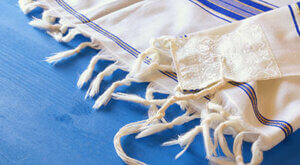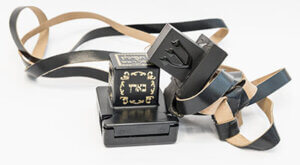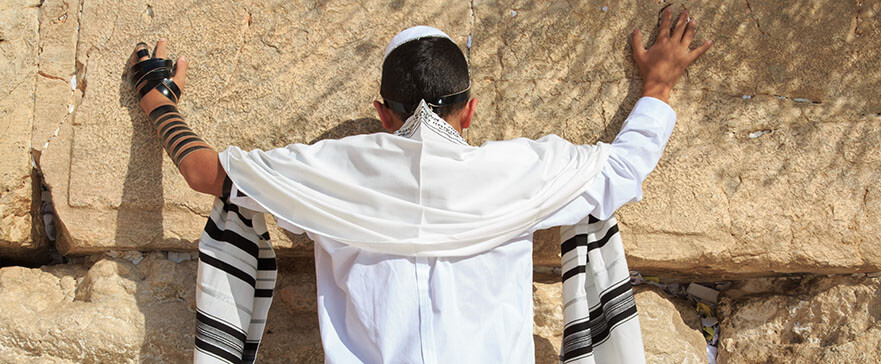The following article is an excerpt from Steve Herzig’s book Jewish Culture and Customs. Steve shares the biblical significance and current Jewish practice of wearing the tallit and tefillin. Learning what these pieces of Jewish worship are and what they mean can help you better understand our Lord and the laws He gave the Jewish people. We hope you build your expertise in Jewish culture and worship through this article!
The Tallit
Daily, at first light (except on the Sabbath and high holy days), Orthodox males (and in some cases, females) don the traditional religious garb, always making sure to put the items in just the right places, in just the right order. Each worship experience serves as an opportunity to identify afresh with their people and their God.
In the Torah we read,
Speak to the children of Israel: Tell them to make tassels on the corners of their garments throughout their generations, and to put a blue thread in the tassels of the corners. And you shall have the tassel, that you may look upon it and remember all the commandments of the Lᴏʀᴅ and do them, and that you may not follow the harlotry to which your own heart and your own eyes are inclined, and that you may remember and do all My commandments, and be holy for your God (Numbers 15:38–40).
These tassels were the key element of the unusual yet attractive garb that came to be known as a tallit (pronounced tah-LEET). Made of wool or linen with blue or black stripes, the tallit has tzitziot (tasseled fringes) hanging from each of its four corners. It is these fringes that are biblical. The tallit is merely the medium to hold them. Originally worn as an outer garment, today it is primarily worn by men (and women in Reform congregations) as a prayer shawl during public and private worship.

Tallit
Many observant Jews wear a tallit katan (small tallit) under the shirt, so that the fringes may be displayed at all times. This, they believe, carries out the command, “that you may look upon it.” The tallit also serves as a memory aid to remember all 613 commandments of the Torah.
How and when a tallit is worn varies among the different cultures of Jewish people. Most men first don a tallit at the time of Bar Mitzvah, while a few wait until their wedding day. Some drape it over their heads, believing that it improves concentration during prayer. Others wear it merely as a shawl. Many twirl one of the fringes around a finger, kiss it, and then touch the Torah as it is carried around the synagogue during a worship service. All then recite the prayer, “Blessed art thou, O Lord our God, King of the universe, who hast sanctified us by thy commandments, and hast commanded us to wrap ourselves in the fringed garment.” Many men are wrapped in tallits for burial. A tear is then made in one of the fringes, symbolizing the end of their obligation to observe the Law.
They were not healed by any supernatural power of the fringes but by the authority of the One wearing them.
Jesus no doubt wore a tallit, as it was the everyday outer garment common in His day. According to the Gospel writers, many people were healed by touching the “border of his garment [tzitziot]” (Mark 6:56; Luke 8:44). They were not healed by any supernatural power of the fringes but by the authority of the One wearing them. Some Jewish men have misused this God-given command by enlarging their fringes as a sign of their great spirituality (Matthew 23:5).
Believers are under no obligation to don the tallit because Jesus Christ fulfilled the Law. Instead, believers are asked to put on several other things, including the new man created in righteousness, the whole armor of God, kindness, humility of mind, meekness, long-suffering, and charity. Paul said it best in Galatians 3:27: “For as many of you as were baptized into Christ have put on Christ.” May we never forget everything He has done for us.
The Tefillin
The tallit is put on first because it is used most often. The tefillin is next in importance and is worn as part of the morning worship, either at home or in the synagogue.

Tefillin
Tefillin (Hebrew, prayer) or phylacteries (Greek, amulet) consist of two small black leather boxes. Attached to these one- to two-inch cubes are long leather straps two to three feet in length. One of the boxes is placed on the shel rosh (forehead), and the other is placed on the shel yad (arm).
The shel yad contains passages of Scripture written by a scribe on one piece of parchment. These passages, taken from the Torah, are Exodus 13:1–16, and Deuteronomy 6:4–9; 11:13–21.
The shel rosh contains the same Scriptures, but they are written on four separate pieces of parchment, the Exodus portion being divided between verses 10 and 11. Each tiny parchment is inserted into one of four separate compartments in the cube.
They are to remind worshipers of their commitment and consecration to the God who redeemed His people after four centuries of bondage in Egypt.
Interpreting these Torah passages literally, the rabbis of old fashioned the tefillin to comply with the command to make them “a sign on your hand and as frontlets between your eyes” (Exodus 13:16). Symbolically, they are to remind worshipers of their commitment and consecration to the God who redeemed His people after four centuries of bondage in Egypt. They are also a reminder that God owns the worshiper’s heart and intellect. For this reason, shel yad points to the heart, and shel rosh is worn on the head.
The shel yad is placed just above the elbow with the box pointed toward the heart, always on the weaker arm. This rule comes from a rabbinic interpretation of Deuteronomy 6:8–9, which teaches that the hand that writes should be the hand that binds.
The leather strap is wrapped around the arm seven times. This practice is based on the seven Hebrew words in Psalm 145:16, “You open your hand and satisfy the desire of every living thing.” Ashkenazic (Eastern European ancestry) Jews wrap the strap clockwise; Sephardic (Mediterranean ancestry) Jews wrap it counterclockwise. The strap is then wound three times around the ring and middle fingers, forming the Hebrew letter for Shaddai, meaning “Almighty.” The three windings recall the passage in Hosea 2:19–20, which contains God’s threefold commitment to Israel: “I will betroth you to Me forever; yes, I will betroth you to Me in righteousness. . . . I will betroth you to Me in faithfulness.”
Zeal is an attribute that has never been found wanting in Judaism. Indeed, those who adhere to its many traditions do not lack courage or conviction, and Christians can learn a great deal from them. Yet a built-in problem arises whenever the traditions themselves replace the reasons for them. Matthew 23:5 records that flaw as stated by the Lord Himself: “But all their works they do to be seen by men. They make their phylacteries broad and enlarge the borders of their garments” (tallit).
The writer to the Hebrews wrote, “But we see Jesus” (Hebrews 2:9). Believers are admonished not to dress with outward adornments but to “put on the Lord Jesus Christ” (Romans 13:14) daily.






Comments 1
Yes….we have so much to learn from each other…It’s not all one way. It’s so beautiful. My heart thanks you!